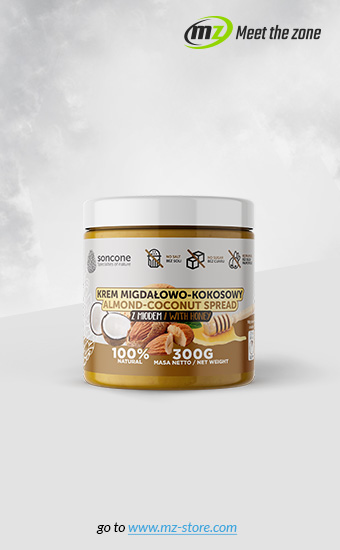The quest for a powerful chest with biceps resembling the tops of icebergs is one of the goals of every bodybuilding adept. We can get a lot of ideas from gyms and mass media about how we could exceed the magical barrier 40 / 45cm in arm circumference. Unfortunately... The methods presented in the gym are not always legal and consistent with the ethics of an athlete, and articles in popular magazines based on reliable scientific articles. In this article, you'll read what, how much and when it’s best to eat to maximize the synthesis of muscle proteins, or "build mass". Remember, however, that the basis for muscle hypertrophy is training, without it even specialized nutritional strategies do not help much.
Do not eat too little!
A small energy deficit of 20% lasting 10 days already reduces the synthesis of muscle proteins by about 20%. This means that by not eating, you limit the potential for muscle mass growth. In order to calculate your energy demand, it’s worth reaching for specialist formulas. If you know the body fat content in your body (BF), use the simple Cunningham formula, if your BF % is not known to you - I recommend the Mifflin-St Jeor formula (both can be found easily online). Using the formula, you will learn your basic metabolism, then multiply it by the PAL factor (physical activity level) and you are ready - now you do not need to eat less kilocalories than you calculated.
How much protein for mass?
Looking at nutritional standards for the population, updated in 2017 by the Food and Nutrition Institute, we note that the recommended protein intake for an average is 0.9 g / kg body weight. A smile has certainly appeared under your nose - and rightly so, because in 1992 it was proven that a diet supplying smaller amounts of protein (0.86 g / kg body weight) impaired the synthesis of whole body protein in athletes doing resistance training compared to menus providing 1.4 and 2.4 g / kg body weight. According to the International Society of Sports Nutrition (ISSN), strength athletes should consume 1.4-2 g of protein per kilogram of body weight during the period of building muscle mass. I am talking about a pool of proteins from both animal sources, of course (e.g. meat, eggs, and cottage cheese) as well as from plant sources (e.g. potatoes, bread, and soy). Winding up the supply to higher values does not bring additional gains in either the biceps, the chest or any other skeletal muscle.
The above factors (adequate energy status and supply of protein throughout the day) are the main, dietary stimuli conditioning the increase in muscle mass. Nevertheless, there are scientific reasons that the development of muscle influences the number of meals during the day, the content of proteins in them, individual amino acids or even the rate of digestion of a given meal.

How many meals to eat for mass?
The number of meals during the day is quite controversial. On the one hand, the old school of bodybuilding encourages people to eat nutritious meals every 2-3 hours. On the other hand - we are encouraged to apply nutritional strategies that provide for periodic fasting, commonly known as IF (Intermittent Fasting) during which (most often) we consume the entire energy demand in the "nutritional window" lasting 6-8 hours, and for the next 16- 18 hours we fast. Closer to the truth are bodybuilders-conservatives. A meal consumed after strength training intensifies the synthesis of muscle proteins for 5 hours. In one of the studies, young athletes were divided into three groups and each of them consumed 80 g of protein (but in a different configuration) within 12 h after finishing the workout. The first group consumed four twenty-gram portions of protein every three hours (4 × 20 g), the second two consumed forty-gram portions of protein every six hours (2 × 40 g), and the last group consumed eight ten-gram portions every hour and a half (8 × 10 g). As it turned out, the synthesis of muscle proteins was most efficiently increased by the group consuming 20 g of protein every four hours. The group consuming 8 × 10 g probably did not exceed the leucine threshold and in the group who consumed 2 × 40 g, the six hours break between meals turned out to be too long. According to the ISSN, the optimal choice is to eat a meal every 3-4 hours.
The protein content in the meal
The protein consists of amino acids. Amino acids are divided into exogenous (EAA, essential amino acids), which the body cannot synthesize and endogenously (produced in the body). Endogenous amino acids are not necessary to enhance the synthesis of muscle proteins. Adoption of 15 g portions of exogenous amino acids before and after training promoted positive protein turnover up to 24 hours after exercise. According to ISSN, the optimal muscle protein synthesis will be obtained when a meal is 10-12 g EAA. In terms of a more practical language, it’s about 20-40 g of full-value protein.
Summary
From the nutritional point of view, the main factors determining the increase in muscle mass is adequate energy supply and protein intake at the level of 1.4-2 g / kg body weight. In order to optimize our increments, we should ensure even distribution of protein between meals, so that it provides a minimum of 10-12 g of exogenous amino acids (20-40 g of full-value protein). Meals should be served every 3-4 hours. The daily pool of protein consumed should include both protein of plant and animal origin, despite the fact that due to the higher content of exogenous amino acids, proteins of animal origin (dairy products, eggs, meat) appear to be more anabolic. It’s worth noting that based on a vegetable diet, a lower content of EAA can be compensated by a larger amount of protein in a meal.
_________________________________________________________________________________________________________________
- Pasiakos S.M., Vislocky L.M., Carbone J.W. Acute energy deprivation affects skeletal muscle protein synthesis and associated intracellular signaling proteins in physically active adults. „J Nutr” 140(4), 2010, 745-51.
- Tarnopolsky M.A., Atkinson S.A., MacDougall J.D., Chesley A., Phillips S., Schwarcz HP., Evaluation of protein requirements for trained strength athletes. „J Appl Physiol (1985).” 73(5), 1992, 1986-95.
- Jäger R., Kerksick C.M., Campbell BI., International Society of Sports Nutrition Position Stand: protein and exercise. „J Int Soc Sports Nutr.” 20, 2017, 14-20.






